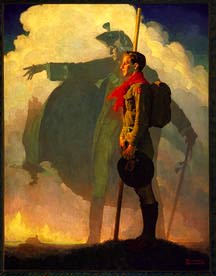BSA Historical Highlights - 1920's
1910s | 1920s | 1930s | 1940s | 1950s
1960s | 1970s | 1980s | 1990s | 2000s
- 1920
- The First National Training Conference for Scout Executives was held in September at Bear Mountain, Palisades Interstate Park. The First World Jamboree was held in England; Boy Scouts from 32 of 52 countries were present; the Boy Scouts of America sent 301 members. The First International Conference of Scout Leaders was held in connection with the jamboree, with International Scout Commissioner Mortimer L. Schiff and others representing the Boy Scouts of America. The quota plan was adopted. The Scout International Bureau was established in London. Membership, December 31, was 478,528. Total members to date, 1,643,988.
- 1921
- Scouts of Washington, D.C., served as aides and guides at the limitation of arms conference. Scouts participated at the annual Eastern States Exposition at Springfield, Mass. Outstanding civic Good Turns were rendered in forest conservation and in connection with the floods at Pueblo, Colo., and San Antonio, Texas. Membership, December 31, was 513,015. Total members to date, 1,879,471.
- 1922
- The Order of the Arrow became an official program experiment. The Second International Conference of Scout Leaders was appointed as a permanent international committee upon which the Boy Scouts of America was represented by Mortimer L. Schiff and Frank Presbrey. The Second National Training Conference for Scout Executives took place at Blue Ridge, N.C. The membership roundup was stimulated by streamer awards by President Warren G. Harding. Membership, December 31, was 534,415. Total members to date, 2,110,973.
- 1923
- The international left handclasp was adopted. Patrol leader conferences and training courses for Scout leaders were developed. The Laura Spelman Rockefeller Memorial Fund advanced $100,000 for the promotion of Boys' Life. The Bureau of Church Relations was established at the national office. Patriotic pilgrimages to the homes of great Americans and to historic spots were made. Membership, December 31, was 587,578. Total members to date, 2,371,520.
- 1924
- The Every Scout a Swimmer program was inaugurated. The first achievement badges were earned by physically disabled Scouts. The Third International Conference of Scout Leaders was attended by 6,000 boys from 33 Scout associations. The Lone Scouts of America merged with the Boy Scouts of America. The Second World Jamboree was held at Copenhagen, Denmark; the U.S. delegation numbered 56. The Third Biennial Conference of Scout Executives was held at Estes Park, Colo. The International Scout constitution and bylaws were adopted. Membership, December 31, was 696,620. Total members to date, 3,144,300.
- 1925
- James J. Storrow of Boston was elected president. The first National Training School for executives opened. Outstanding service was rendered by Scouts in the Illinois tornado, California earthquake, and Louisiana fire. A delegation from Boy Scouts of America visited South America to advance Scouting there. Membership, December 31, was 756,857. Total members to date, 3,436,294.
- 1926
- President James J. Storrow died in March and Vice President Milton A. McRae was elected to fill his term. At the annual meeting in May, Walter W. Head was elected president. Sir Robert S. S. Baden-Powell, founder of Scouting, attended the annual meeting and traveled throughout the country inspecting Scouting centers. The first Silver Buffalo Awards for distinguished service to boyhood were presented. Twenty-two awards were given: the first to Baden-Powell and the second to the Unknown Scout whose Good Turn brought Scouting to America. The Fourth International Scout Conference was held at Kandersteg, Switzerland. The Fourth Biennial Conference of Scout Executives was held at Hot Springs, Ark. The National Executive Board authorized development of a program for younger boys. Exceptional Scout service was rendered in the Florida hurricane and Arkansas flood. Membership, December 31, was 783,574. Total members to date, 3,749,244.
- 1927
- Eagle Palms were added to the list of awards. Twelve new rural merit badges were added, bringing the total to 89. Eight Sea Scouts were taken on the Borden-Field Museum Expedition to the Bering Sea. Exceptional service was rendered by Scouts in the Mississippi and Vermont flood disasters and the St. Louis tornado. The national office was moved to its new enlarged quarters at 2 Park Avenue, New York, N.Y. Membership, December 31, was 785,633. Total members to date, 4,095,988.
- 1928
- Three Scouts— David R. Martin, Douglas Oliver, and Dick Douglas—accompanied the Martin Johnson Expedition to Africa. The Fifth National Training Conference for Scout Executives was held at Cornell University. The 18th annual meeting was held in San Francisco. Four Scouts participated in the Lincoln Highway covered-wagon tour from coast to coast, and Paul A. Siple, a Sea Scout, accompanied Commander Richard E. Byrd to the Antarctic. Membership, December 31, was 819,791. Total members to date, 4,499,908.
- 1929
- The Third World Jamboree, held at Birkenhead, England, where 1,300 Scouts and Scouters represented the Boy Scouts of America, was attended by 50,000 Scouts representing 73 lands. It was followed by the Fifth International Scout Conference. The Cub Scout program was put into operation on an experimental basis. Registration of all Scouters was authorized. Membership, December 31, was 833,897. Total members to date, 4,779,219.